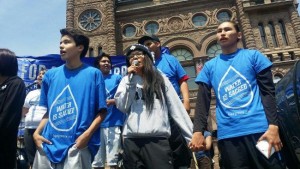Grassy Narrows First Nation seeking justice for their right to a basic need: clean water

Grassy Narrows youth performing song on stage to Grassy Narrows rally supporters in Toronto, Ontario, on June 2.
Youth traveled 1,700 kilometers by bus from Grassy Narrows First Nation, Ontario, to Toronto, Ontario, to join the over 1000 supporters at the rally calling for justice for Grassy Narrows First Nation at Queen’s Park that took place on June 2.
The justice that Grassy Narrows First Nation, northwest of Thunder Bay, is seeking and fighting for is for the regular mercury poisoning cases that have long plagued the reserve since the 1960’s after a local paper and chemical mill shut down. Additionally, the toxicity of the water is only worsening as the years go by with increasing levels of uranium amongst other possible chemicals.
“They are the future and they are the ones we have been fighting for all this time,” said Grandmother Judy Da Silva of Grassy Narrows First Nation to the crowd of supporters.
Da Silva was referring to the busload of youth who had traveled two days in order to be in attendance of the continued fight for clean water. The youth had just performed a song they wrote about their community called, Home to Me. “This song that these young people made has made me cry so many times,” said Da Silva. “I wanted to cry again, but I kept my composure so I could talk to you,” she added.
“We are a powerful people,” she said, “and I want people to understand that we are not weak. We are strong and we’re not going to give up. It’s a big monster we’re fighting and that fight is to protect our water and the future generations of children,” she boldly stated.
Da Silva told the supporters, “With you standing behind us and pressuring the government, you amplify our voice.”
Faisal Moola, a scientist with the David Suzuki Foundation and professor at York University and University of Toronto, reminded the supporters of the history of Grassy Narrows. Moola began by recounting that “in 1962, the Ontario Government gave permission to a pulp and paper company in Dryden to dump 10,000 kilograms of toxic mercury waste into the Wabigoon River. The people of Grassy Narrows have been dealing with the results of that ever since.”
Moola talked about a report authored by three renowned scientists that was just released. They have said the Wabigoon River can be cleaned of the mercury. “The water can be cleaned, the fish can be safe again, but it’s only going to happen if there is political will,” said Moola.
On behalf of the David Suzuki Foundation and their tens of thousands of supporters across the country, Moola urged Premier Wynne to listen to the science and finally bring justice to the people of Grassy Narrows.
“It’s time to bring an end to government-sanctioned abuses of First Nations people,” said Dawn Bellerose, the Aboriginal representative on the Executive Board of the Canadian Union of Public Employees (CUPE), Canada’s largest union representing over 635,000 members in health care, emergency services, education, early learning and child care, municipalities, social services, and more across the country.
“I came here today to say that 250,000 CUPE members in Ontario stand in solidarity with the people from Grassy Narrows,” added Bellerose. Bellerose said CUPE is committed to join the fight to get the government to clean the river of mercury and stop all industrial logging in and around Grassy Narrows.
Chief Simon Fobister of Grassy Narrows said the support for their struggle has been greatly appreciated, especially the support given by the various organizations. Fobister is hopeful that the new report, funded by the Ontario Government, will lead to positive action from Premier Wynne. “Our main goal is to get the river cleaned up,” he said.
“All these decades they failed to do so. I hope this time they won’t drop the ball. I hope this time, they’ll do the right thing,” Fobister added while on the subject of the river clean up.
The group marched from Queen’s Park along University Avenue and onto College Street, stopping at some major intersections for a Round Dance. The march ended at Allan Gardens, at Jarvis and Carlton streets.
Tori Cress of Idle No More and citizen of Beausoleil First Nation, marched with Grandmother Judy Da Silva. “This is a great opportunity for the rest of Ontario to get engaged with Indigenous communities, bringing the oppressive problems like environmental racism right to the Legislature,” Cress said.
Cress passionately stated that “it’s important to make people aware that Northern Ontario is a dumping ground for chemicals. And it’s gonna keep happening like with the Ring of Fire and we need to make people aware of the environmental damages we’re gonna be facing in the future.”




